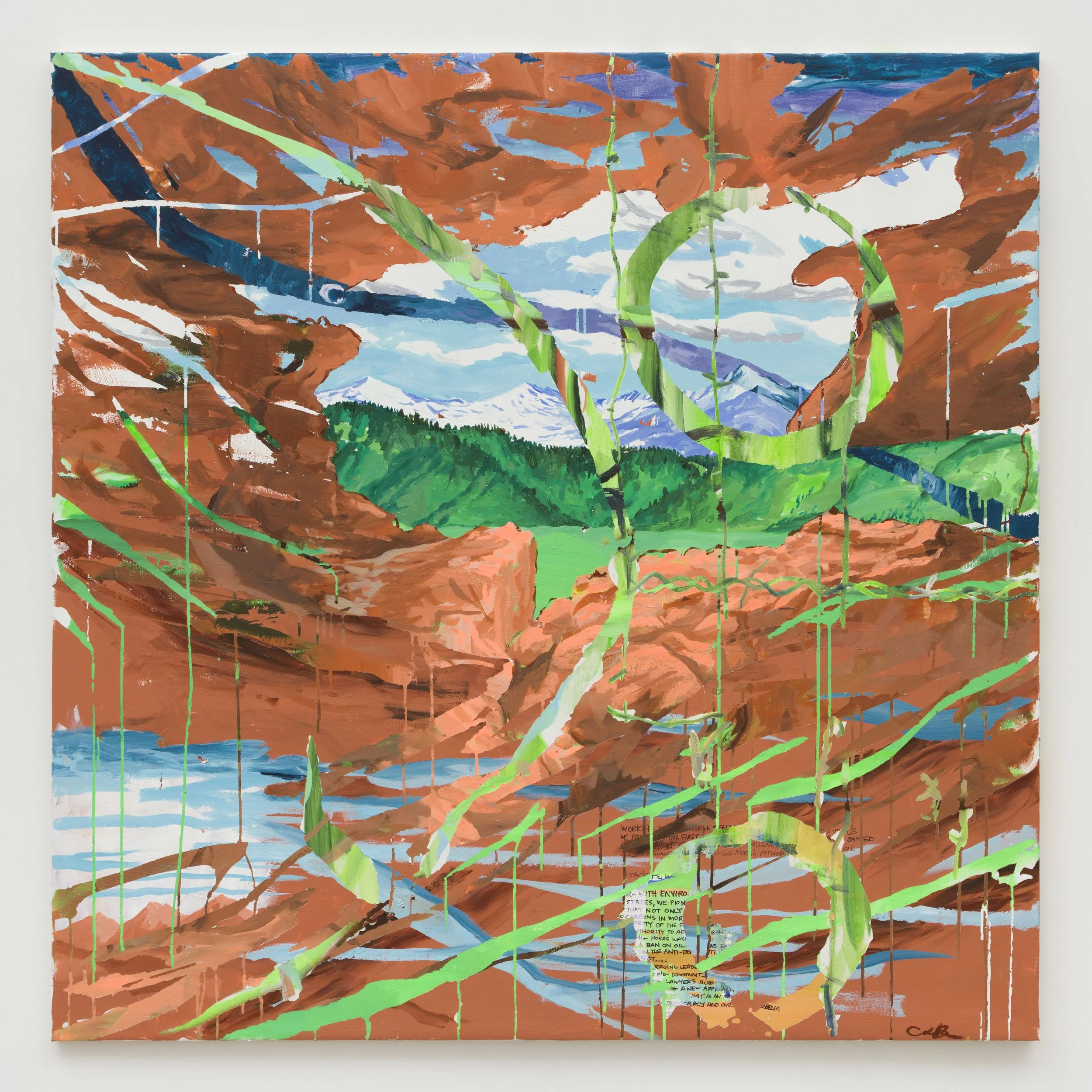ESTEBAN CABEZA DE BACA
ABOUT THE ARTIST
Esteban Cabeza de Baca’s childhood hometown of San Ysidro, CA effectively straddled the US–Mexico border, as did his family. During the 1990s to early 2000s, Cabeza de Baca lived in west Denver, getting acculturated to the Chicano community in all its rich diversity. He employs a broad range of techniques in his paintings and sculptures to confound myopic perspectives of American history. Often set in the landscape of the American Southwest, his work depicts important moments where social, political, environmental, and familial narratives intertwine.
Cabeza de Baca’s recent solo exhibitions include Alma, Garth Greenan Gallery, NYC.; Let Earth Breathe, Crystal Bridges Museum, Arkansas; Life is one Drop in Limitless Oceans..., Kunstfort, Vijfhuizen, Netherlands. Cabeza de Baca’s work is in numerous collections such as Harvard University, MCA San Diego, and Beth de Woody collection. Esteban graduated from Denver School of the Arts in 2003 then received a BFA from The Cooper Union in 2010 and an MFA from Columbia University in 2014. He currently lives and works between the US borderlands and Queens, NY, and is represented by Garth Greenan Gallery.
Watch the Art 21 video profile of the artist here.
ABOUT THE ARTIST TALK
Tuesday, March 19, 2024
Mary Harris Auditorium
In his artist talk, Cabeza de Baca discussed how his artistic practice, inspirations, and development emanated from his experiences as a student at Denver School of the Arts in the late 1990s, the impact of New York Abstract Expressionists, and the heart of where his paintings lie – out West. His creative practice is heavily influenced by his parents’ active participation in the Chicano movement in the North American Southwest. Themes like Rasquachismo, a Chicano aesthetic and attitude that venerates resourcefulness, and Nepantla, the concept of in-betweenness experienced at the intersection of place and culture, run through his work and artistic approach. In this talk, he also shared his interest in the struggle for justice for migrant communities, the ways time can change our perception of space, and Indigenous knowledge that incorporates feminist ecological thinking. This talk confronted the mistranslated mythologies of the Southwest and offered a revised account of history that inspires and celebrates art’s role in establishing solidarity along differing racial, class, and social lines.
About the Solo Exhibition
West of Federal
Tuesday, February 6, 2024 – Friday, March 22, 2024
Philip J. Steele Gallery
Gallery hours: Monday – Friday, 11 am – 4 pm
Curated by Gretchen Marie Schaefer
RMCAD is honored to present Esteban Cabeza de Baca’s first solo exhibition in Colorado, West of Federal. With formative roots in Denver, the exhibition is a homecoming for the artist and brings together recent paintings that reveal how connected the artist remains to Colorado and the region while working in his Queens, New York studio. This blurring of locations and making connections across time echoes Cabeza de Baca’s paintings which act like time and space traveling devices, collapsing a location’s everchanging borders and its past, present, and future into a single picture plane.
The exhibition title, West of Federal, is a direct reference to the culturally significant Federal Boulevard, a vibrant west-side corridor of Denver with a long history of Mexican American residents, activism, language, food, culture, and art. Cabeza de Baca is heavily influenced by his Native American and Mexican heritage, the environmental and human rights advocacy of his parents, and landscapes significant to the artist’s life and family in the North American Southwest. Specifically, Cabeza de Baca draws inspiration from his childhood hometown of San Ysidro, CA bordering Tijuana, Mexico, the birthplace of his mother, his father’s original home of New Mexico, and Denver where Cabeza de Baca lived in the 1990s to early 2000s. Like Federal Boulevard, these places have been and continue to be shaped by Indigenous culture and people and the impacts of colonization and gentrification.
West of Federal by Esteban Cabeza de Baca, installation view in RMCAD’s Philip J. Steele Gallery. Left: Twins, acrylic and cochineal with indigo on canvas, 2024. Right: Glacial Timelapse, acrylic and cochineal on canvas, 2023.
Esteban Cabeza de Baca. How Mora Banned Fracking, 2022. Acrylic on canvas. Courtesy of the artist.
PRIVATE RMCAD events
STUDENT-LED Q+A SESSION
Wednesday, March 20, 2024
Philip J. Steele Gallery
Student-Led Q + A Sessions are private, casual, in-person conversations open to RMCAD students, faculty, and staff. Guided by student voices, these discussions generate valuable professional advice for all students directly from the student perspective. Fine Arts student Sebastian Ramirez led the conversation with Esteban Cabeza de Baca.
Fine Arts student Sebastian Ramirez interviewing Esteban Cabeza de Baca in front of his artwork in the Philip J. Steele Gallery.
ONE-ON-ONES with ESTEBAN CABEZA DE BACA
Wednesday, March 20, 2024
Through an application process, RMCAD online and on-ground students applied for one-on-one meetings with the visiting artist. Selected students had the opportunity to share their work and get feedback from Esteban Cabeza de Baca.
Recommendation List
VASD Program visiting artists provide a recommendation list that gives insight into their work, practice, and research. Artist Esteban Cabeza de Baca recommends the following:
Glitch Feminism, A Manifesto by Legacy Russell
Of Cities and Women by Etel Adnan
Teaching to Transgress, Education as the Practice of Freedom by bell hooks
Braiding Sweetgrass by Robin Wall Kimmerer
Feminist Iconography by bell hooks and Amalia Mesa-Bains
Freedom is a Constant Struggle, Ferguson, Palestine, and the Foundations of a Movement by Angela Y. Davis
Borderlands / La Frontera, The New Mestiza by Gloria Anzaldúa
Staying with the Trouble, Making Kin in the Chthulucene by Donna J. Haraway
How to Not Fuck Up Your Art World Happiness by Christoph Noe
Social Forms of Art Journal, Issue 1 – Civics, June 2018
Notes from the Woodshed by Jack Whitten
Lo-TEK: Design by Radical Indigenism by Julia Watson
“Looking at Surrealist Art in Our Own Surreal Age,” The New York Times by Kate Guadagnino
My Grandmother’s Hands, Racialized Trauma and the Pathway to Mending Our Hearts and Bodies by Resmaa Menakem
The Carrier Bag Theory of Fiction by Ursula K. Le Guin
The Origin of Others by Toni Morrison
Traction by Tirdad Zolghadr
“Unruly Edges: Mushrooms as Companion Species” by Anna Tsing, Department of Anthropology, University of California, Santa Cruz
Winning the Green New Deal, Why We Must, How We Can edited by Varshini Prakash and Guido Girgenti
“Fail Better” by Zadie Smith




